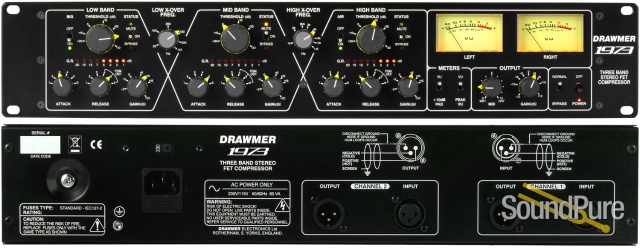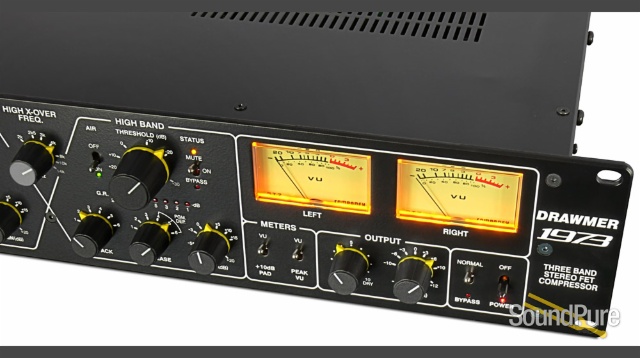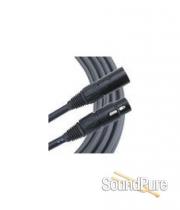-
Call Us Toll Free888-528-9703
-
Local/International (+1)919-682-5552
- Call Us! Toll Free! 888-528-9703
- Local / International (+1) 919-682-5552

Drawmer 1973 Three Band FET Stereo Compressor From Drawmer
The award winning 1973 is a multi-band compressor with the versatility, control and ability to shape sound that no full band compressor could ever provide and at an affordable price.
$1,979.00
Retail: $2,199.00
"Experience the Difference"
 Payments as low as $45/mo.
Payments as low as $45/mo.
Manufacturer's Description from Drawmer
Expanding on the renowned range of dynamics processors Drawmer introduce an affordable Three Band Stereo FET Compressor that every engineer will completely appreciate - the 1973. The culmination of 30 years of development and experience, the 1973 combines the functionality and control of the world class Drawmer S3 with the familiarity and quality of the illustrious 1960 and 1968, providing three bands of transparent, intuitive compression for the price of a conventional single full band compressor.
How does the 1973 differ from a full band compressor? In essence, the 1973 comprises a set of crossover filters that splits the audio signal into three frequency bands, each split signal then passes through its own compressor and is independently adjusted, after which the signals are recombined and the final Wet/Dry mix and levels can be adjusted. The advantage is that one band's compression has no affect on the others.
What's so good about a three band compressor anyway? The 1973 can pull off amazing feats that a single-band compressor could never accomplish. For example, it can easily prevent an acoustic guitar, cello, or double bass from sounding boomy on low notes without thinning the highs.
Are you recording a vocal track that sounds too shrill? The timbre can easily be altered without eliminating detail and clarity. Adding heavier compression in the bass band can add to the thickness and richness of the voice, in the mid band raspiness is controlled, whilst compression to the high band can give sizzle and definition to an otherwise bland voice. In addition, sibilance can easily be tamed.
In a mastering situation, having independent control over each band can resolve a problem mix, pulling out individual instruments, brightening the brilliance/air or making the bottom end of a mix sound huge while simultaneously avoiding "pumping" or "breathing" artifacts and increasing headroom.
Features:
- Standard intuitive controls such as Threshold, Gain, Switched Attack & Release with Gain Reduction Metering on Each Band.
- Fast Reacting Soft Knee F.E.T. Design with excellent Left/Right Tracking across the Full Range of compression.
- Variable Wet/Dry Mix plus Output Gain Knobs give a 'Parallel Compression' function without the need for external mixing devices, providing Complete and Effortless Control over the amount of compression used and Output Levels.
- Variable Band Split Filters at a 6dB Per Octave slope with Switch-able Mute and Bypass on Each Band make 'Tuning In' to a Frequency Simple.
- ‘Big’ and 'Air' Modes Help to preserve the Very Deep Lows and Enhance the Sparkling Highs.
- Two Analogue V.U. Meters with Switchable +10dB Meter Rescale Modes and a Switchable ‘Peak’ mode to Display Fast Transients Not Normally Seen on Conventional V.U.s.
- Dedicated Gain Reduction Meters On Each Band.
- Internal Low Hum Toroidal Linear Power Supply with Voltage Selector Switch.
- Classic Drawmer Build Quality with Rugged Steel Chassis and Aluminium Front Panel.

About Manufacturer
Specifications
| Frequency Response |
<5 Hz to 51 kHz (-1 dB)
<3 Hz to 70 kHz (-3 dB) |
| Input Impedance |
≥20 Kilohms
|
| Output Impedance |
100 Ohms
|
| Maximum Input Level |
+26 dBu
|
| Maximum Output Level |
+25 dBu (Into 10-Kilohm Load)
|
| Crosstalk |
<-80 dB (at 1 kHz)
|
| Noise |
Wideband: -82 dB
22 Hz to 22 kHz: -87 dB |
| THD + N |
0 dB: 0.03%
10 dB: 0.07% 20 dB: 0.5% |
| Audio I/O |
2x XLR 3-Pin Line Input (1 Stereo Pair)
2x XLR 3-Pin Line Output (1 Stereo Pair) |
| Power Source |
AC Input (Built-In)
|
| AC Input Power |
Changing Voltage Requires Manual Switching
115 to 230 VAC, 50 / 60 Hz |
| Power Consumption |
60 VA
|
| Mounting |
Front: 3x Standard Rackmount Hole
|
| Color |
Black
|
| Material of Construction |
Steel, Aluminum
|
| Certifications |
CE, WEEE
|
| Dimensions |
19 x 10.6 x 3.5" / 48.2 x 27 x 8.8 cm
|
| Weight |
9.3 lb / 4.2 kg
|
| Package Weight |
11.355 lb
|
| Box Dimensions (LxWxH) |
22.1 x 16.9 x 6.7"
|
















